Assessment of Road Noise Pollution in Urban Residential Areas—A Case Study in Piteşti, Romania
Abstract
:1. Introduction
- have not been implemented measures to regulate in one-way road traffic for some of the specified proposed streets;
- no bicycle lanes have been built to promote this alternative mode of transport;
- a road belt was not made for the western part of the city;
- the road clothes for several of the specified streets were not rehabilitated;
- the Park & Ride system, which would have reduced private transport, was not promoted;
- not all measures have been taken to reorganize road traffic so that road traffic performance is improved (road network service level and road traffic safety) and compliance with European pollution rules is ensured.
2. Materials and Methods
- Weighting filters: A (responds to sound same way as the human ear), B, C, 1/1 or 1/3 octave (16 Hz–20 kHz);
- Dynamic range in excess of 120 dB;
- Peak level measurement: <50 ms;
- Measuring range: 0.125 s–12 h.
3. Results
- measurement of the global noise level over time and noise frequency analysis, using software based on the FFT (Fast Fourier Transform) method, to highlight the influence of traffic composition and vehicle speed;
- determination of the physical and psychophysical noise indices at 3 road intersections–to make a comparative analysis in terms of noise.
3.1. Noise Level Measurement of and Frequency Analysis
- It was highlighted that the road noise at the traffic light intersection has a cyclical character, as well as the flows of vehicles that are formed-with decelerations and accelerations that contribute to a substantial increase in noise level);
- The noise level (acoustic pressure) reaches high values of 73.5 dB, which is explained by the braking and acceleration processes and less by the heavy vehicles presence in traffic;
- Noise signal peaks are captured, which are, in this case, determined by the horn use (unlawful!). They will have to be eliminated, being aberrant values (the program allows this) and then the noise level will be recalculated;
- The recording also shows the presence of a truck, which, over a relatively long period of time, contributes to an increase in noise.
3.2. Noise Indices Determination at Road Intersections in the Central Area of Piteşti
- The Maior Şonţu traffic light intersection;
- The Podul Viilor roundabout intersection;
- The Rectorship roundabout intersection.
3.2.1. The Maior Şonţu Traffic Light Intersection (Maior Şonţu Street-Târgul Din Vale Street)
- Noise climate, c:
- Psychophysical index of noise pollution level, LNP:
- Psychophysical index of traffic noise, TNI:
- The average noise level, Lm:
- Noise level standard deviation, σ:
- The psychophysical index, LAeq [dB], was calculated automatically by the dedicated software for noise analysis, its value being: LAeq = 72.7 dB. It is a value lower than the one previously measured, at 5.30 p.m. (73.5 dB), which is explained by the fact that although the capacity of the East arm is exceeded by the traffic demand in both situations, at 2.00 p.m. the proportion in the traffic composition of heavy vehicles is lower.
3.2.2. The Podul Viilor Roundabout Intersection (Calea Bascovului Street-Calea Bucureşti Street)
3.2.3. The Rectorship Roundabout Intersection (Târgul Din Vale Street-Gheorghe Şincai Street)
4. Discussion
- The waiting line has very high values, so each vehicle waits at least 2 times for the Red light until it manages to cross the intersection on the Green light, so the demand is much higher than the capacity offered by the group of the 2 lanes, so that they circulate on the entire duration of the Green light;
- The vehicles turn left, the proportion of heavy vehicles is about 5%, and the road gradient is about 2%;
- Vehicles starts and runs in 1st gear, at high engine load speed.
- The entry volume on the West arm is 1100 PCU/hour, there are no heavy vehicles, and access is made in medium acceleration mode.
- The conflict flow corresponding to the West arm has the value of Vconflict = 1100 veh-et/h, it is made up of vehicles moving at constant speed, in 1st gear, and the proportion of heavy vehicles is about 5%.
5. Conclusions
- All noise indices (physical or psychophysical) have higher values at the traffic lights Maior Şonţu than at the two roundabouts Podul Viilor and Rectorship. This conclusion agrees very well with what has been reported in the literature [39,40,41,42,43] and with the results of traffic measurements at the 3 analyzed road junctions. The explanation is given by the fact that traffic at traffic lights is intermittent [36,44], with strong accelerations in 1st gear (specific for on-off mode). On the contrary, at the roundabout, traffic moves along the ring and at the exit from the intersection, and for the entrance to the intersection, traffic can move (without stopping, with average acceleration in the 1st lane) or it can be of the “stop and go” type (for light braking and acceleration in 1st gear) [45];
- It was found that the differences for the physical indicators measured in the 3 intersections agree with the data obtained by simulation with specialized noise prediction software LimA [16,17], of 1–2 dB (A), while for the psycho-physical indicators the differences reach 3–4 dB, which is explained by the different structure of the road traffic from the 3 intersections (composite or homogeneous) and the differences between travel regimes.
- The differences (at the detriment of the traffic light intersection) are larger in the case of psychophysical indices (noise level psychophysical index LNP, traffic noise psychophysical index TNI, psychophysical index Leq), which confirms that they are analytically defined, so as to highlight the differences in noise pollution felt by the human body in different situations [46];
- The noise produced by horn reaches very high values-values exceeding an instantaneous LAF noise level of 90 dB, which were excluded when processing the data, being aberrant values-which justifies the prohibition of ringing on the territory of the localities, except in cases of necessity;
- For the traffic light intersection case, the average noise level is much higher in contrast with the roundabout intersections, and the noise dispersion is much wider (this causes a higher noise climate), which also demonstrates from this point of view that the roundabouts are higher-ranking, than the traffic lights in relation to the noise pollution caused by road traffic;
- Comparing the two roundabout intersections-Podul Viilor, respectively, Rectorat-it is found that the values of the noise indices are very close, but for all the indices, higher values were obtained at the Podul Viilor intersection, which is explained by the difference between the regime of driving of vehicles at the two intersections: in Podul Viilor roundabout access with high accelerations in 1st gear, to reduce the access time when the vehicles to which they must be given priority circulate at high speed; in Rectorat roundabout access with “stop and go” traffic (with light braking and light acceleration in 1st gear).
Author Contributions
Funding
Institutional Review Board Statement
Informed Consent Statement
Data Availability Statement
Conflicts of Interest
References
- Alharbi, E.A.; Abdel-Malek, L.L.; Milne, R.J.; Wali, A.M. Analytical Model for Enhancing the Adoptability of Continuous Descent Approach at Airports. Appl. Sci. 2022, 12, 1506. [Google Scholar] [CrossRef]
- European Commission. Directive 2002/49/EC of the European Parliament and of the Council of 25 June 2002 Relating to the Assessment and Management of Environmental Noise. Available online: https://publications.europa.eu/en/publication-detail/-/publication/27d1a64e-08f0-4665-a258-96f16c7af072/language-en (accessed on 20 November 2018).
- Indaco Lege 5. Legea Nr. 265/2006 Pentru Aprobarea Ordonanței de Urgență a Guvernului Nr. 195/2005 Privind Protecția Mediului (Law No. 265/2006 for the Approval of the Government Emergency Ordinance no. 195/2005 on Environmental Protection). Available online: https://lege5.ro/Gratuit/ha3tambq/legea-nr-265-2006-pentru-aprobarea-ordonantei-de-urgenta-a-guvernului-nr-195-2005-privind-protectia-mediului (accessed on 20 November 2018).
- Park, T.; Kim, M.; Jang, C.; Choung, T.; Sim, K.-A.; Seo, D.; Chang, S.I. The Public Health Impact of Road-Traffic Noise in a Highly-Populated City, Republic of Korea: Annoyance and Sleep Disturbance. Sustainability 2018, 10, 2947. [Google Scholar] [CrossRef] [Green Version]
- Gallo, M.; De Luca, G. Evaluation of Urban Traffic Plan Scenarios in Terms of Traffic Noise Abatement. Int. J. Transp. Syst. 2016, 1, 98–103. [Google Scholar]
- Alves, J.A.; Silva, L.T.; Remoaldo, P.C.C. The Influence of Low-Frequency Noise Pollution on the Quality of Life and Place in Sustainable Cities: A Case Study from Northern Portugal. Sustainability 2015, 7, 13920–13946. [Google Scholar] [CrossRef] [Green Version]
- Wunderli, J.M.; Pieren, R.; Habermacher, M.; Vienneau, D.; Cajochen, C.; Probst-Hensch, N.; Röösli, M.; Brink, M. Intermittency ratio: A metric reflecting short-term temporal variations of transportation noise exposure. J. Expo. Sci. Environ. Epidemiol. 2016, 26, 575–585. [Google Scholar] [CrossRef] [PubMed]
- Alsina-Pagès, R.M.; Benocci, R.; Brambilla, G.; Zambon, G. Methods for noise event detection and assessment of the sonic environment by the harmonica index. Appl. Sci. 2021, 11, 8031. [Google Scholar] [CrossRef]
- Brink, M.; Schäffer, B.; Vienneau, D.; Foraster, M.; Pieren, R.; Eze, I.C.; Cajochen, C.; Probst-Hensch, N.; Röösli, M.; Wunderli, J.-M. A survey on exposure-response relationships for road, rail, and aircraft noise annoyance: Differences between continuous and intermittent noise. Environ. Int. 2019, 125, 277–290. [Google Scholar] [CrossRef]
- Brambilla, G.; Benocci, R.; Confalonieri, C.; Roman, H.E.; Zambon, G. Classification of urban road traffic noise based on sound energy and eventfulness indicators. Appl. Sci. 2020, 10, 2451. [Google Scholar] [CrossRef] [Green Version]
- Manvell, D.; Ballarin Marcos, L.; Stapelfeldt, H.; Sanz, R. SADMAM-Combining Measurements and Calculations to Map Noise in Madrid. In Proceedings of the Inter-Noise 2004, Prague, Czech Republic, 22–25 August 2004. [Google Scholar]
- Benocci, R.; Bellucci, P.; Peruzzi, L.; Bisceglie, A.; Angelini, F.; Confalonieri, C.; Zambon, G. Dynamic Noise Mapping in the Suburban Area of Rome (Italy). Environments 2019, 6, 79. [Google Scholar] [CrossRef] [Green Version]
- De Coensel, B.; Sun, K.; Wei, W.; Van Renterghem, T.; Sineau, M.; Ribeiro, C.; Can, A.; Aumond, P.; Lavandier, C.; Botteldooren, D. Dynamic noise mapping based on fixed and mobile sound measurements. In Proceedings of the 10th European Congress and Exposition on Noise Control Engineering (Euronoise 2015), Maastricht, The Netherlands, 31 May–3 June 2015. [Google Scholar]
- Zambon, G.; Benocci, R.; Angelini, F.; Brambilla, G.; Gallo, V. Statistics-based functional classification of roads in the urban area of Milan. In Proceedings of the 7th Forum Acusticum Krakow, Krakow, Poland, 7–12 September 2014. [Google Scholar]
- Wei, W.; Van Renterghem, T.; De Coensel, B.; Botteldooren, D. Dynamic noise mapping: A map-based interpolation between noise measurements with high temporal resolution. Appl. Acoust. 2016, 101, 127–140. [Google Scholar] [CrossRef] [Green Version]
- Džambas, T.; Ahac, S.; Dragčević, V. The impact of intersection type on traffic noise levels in residential areas Conference. In Proceedings of the 3rd International Conference on Road and Rail Infrastructures—CETRA 2014, Split, Croatia, 28–30 April 2014. [Google Scholar]
- Covaciu, D.; Florea, D.; Timar, J. Estimation of the noise level produced by road traffic in roundabouts. Appl. Acoust. 2015, 98, 43–51. [Google Scholar] [CrossRef]
- Boroiu, A.-A.; Neagu, E. Trafic Rutier şi Siguranţa Circulaţiei Rutiere. In Aplicaţii (Road Traffic and Road Safety. Applications); Editura Universității din Piteşti: Piteşti, Romania, 2015; pp. 81–96. [Google Scholar]
- Zambon, G.; Roman, H.E.; Smiraglia, M.; Benocci, R. Monitoring and Prediction of Traffic Noise in Large Urban Areas. Appl. Sci. 2018, 8, 251. [Google Scholar] [CrossRef] [Green Version]
- Ţârulescu, S. Studii şi Cercetări Privind Influența Traficului Rutier Urban Asupra Emisiilor Poluante (Studies and Research on the Influence of Urban Road Traffic on Polluting Emissions). Ph.D. Thesis, Transilvania University of Braşov, Braşov, Romania, 2009. [Google Scholar]
- Alahmer, A.; Alahmer, H.; Handam, A.; Rezk, H. Environmental Assessment of a Diesel Engine Fueled with Various Biodiesel Blends: Polynomial Regression and Grey Wolf Optimization. Sustainability 2022, 14, 1367. [Google Scholar] [CrossRef]
- Fan, S.; Li, J.; Li, L.; Chu, Z. Noise Annoyance Prediction of Urban Substation Based on Transfer Learning and Convolutional Neural Network. Energies 2022, 15, 749. [Google Scholar] [CrossRef]
- Yuan, M.; Wang, J.; Wang, Y.; Shao, S. Study on Noise Reduction with Paving Different Low Noise Pavement Materials. Appl. Sci. 2021, 11, 10273. [Google Scholar] [CrossRef]
- Primăria Municipiului Piteşti. Planul de Acţiune Pentru Reducerea Nivelurilor de Zgomot în Municipiul Piteşti. Raport Final, Octombrie 2012 (Action Plan to Reduce Noise Levels in Piteşti Municipality. Final Report, October 2012). Available online: http://www.primariapitesti.ro/portal/arges/prim/portal.nsf/03D7BABD6A420024C22580EA00389B02/$FILE/399%20HCL%20privind%20aprobarea%20Planului%20de%20actiune%20pentru%20reducerea%20nivelurilor%20de%20zgomot%20in%20municipiul%20Pitesti%20I.pdf (accessed on 18 November 2018).
- Primăria Municipiului Piteşti. Planul de Acţiune Pentru Gestionarea şi Reducerea Nivelurilor de Zgomot în Municipiul Piteşti, Raport Final, Iunie 2018 (Action Plan for the Management and Reduction of Noise Levels in the City of Piteşti, Final Report, June 2018). Available online: http://www.primariapitesti.ro/portal/arges/prim/portal.nsf/239BA4F67782EE4AC22582AA0040969B/%24FILE/Proiect%20hotarare%20reducere%20zgomot.pdf (accessed on 15 January 2020).
- Xu, H.; Zhao, G. Assessing the Value of Urban Green Infrastructure Ecosystem Services for High-Density Urban Management and Development: Case from the Capital Core Area of Beijing, China. Sustainability 2021, 13, 12115. [Google Scholar] [CrossRef]
- Pârlac, S.; Popa, D.; Pandrea, N. Controlul şi Atenuarea Zgomotelor şi Vibraţiilor la Automobile. Lucrări de Laborator (Control and Attenuation of Car Noise and Vibration. Laboratory Work); Editura Universităţii din Piteşti: Piteşti, Romania, 1998; pp. 78–82. [Google Scholar]
- Kleizienė, R.; Šernas, O.; Vaitkus, A.; Simanavičienė, R. Asphalt Pavement Acoustic Performance Model. Sustainability 2019, 11, 2938. [Google Scholar] [CrossRef] [Green Version]
- Facebook. Piteşti, Oraşul Sufletului Meu. (Piteşti, the City of My Soul). Available online: https://www.facebook.com/pitesti1/videos/pasarela-podul-viilor/1705588902992264/ (accessed on 20 November 2018).
- Timar, J. Studii şi Cercetări Privind Optimizarea Fluxurilor Rutiere Urbane (Studies and Research on the Optimization of Urban Road Flows). Ph.D. Thesis, Transilvania University of Braşov, Braşov, Romania, 2010. [Google Scholar]
- Kwasiborska, A.; Skorupski, J. Assessment of the Method of Merging Landing Aircraft Streams in the Context of Fuel Consumption in the Airspace. Sustainability 2021, 13, 12859. [Google Scholar] [CrossRef]
- Larson-Davies Co. Model 831 Technical Reference Manual. Available online: http://www.larsondavis.com/SoundAdvisor-Model-831C-Manual.pdf (accessed on 10 December 2018).
- SINUS Messtechnik GmbH. Available online: https://sinus-leipzig.de/en/produkte/software/samurai (accessed on 10 December 2018).
- Marquart, H.; Schuppan, J. Promoting Sustainable Mobility: To What Extent Is “Health” Considered by Mobility App Studies? A Review and a Conceptual Framework. Sustainability 2022, 14, 47. [Google Scholar] [CrossRef]
- Boroiu, A.-A. Studii şi Cercetări Privind Reducerea Poluării Fonice Produse de Autovehicule Prin Organizarea Circulaţiei Rutiere (Studies and Research on Reducing Road Noise Pollution by Organizing Road Traffic). Ph.D. Thesis, University of Piteşti, Piteşti, Romania, 2017. [Google Scholar]
- Boroiu, A.-A.; Neagu, E.; Boroiu, A.; Pârlac, S. Study of the possibilities to improve the service level of traffic light intersections by road traffic micro-simulation. In Proceedings of the 30th SIAR International Congress of Automotive and Transport Engineering, Craiova, Romania, 23–25 October 2019; Dumitru, I., Covaciu, D., Racila, L., Rosca, A., Eds.; Springer: Cham, Switzerland, 2020; pp. 349–358. [Google Scholar] [CrossRef]
- De Fazio, R.; Dinoi, L.M.; De Vittorio, M.; Visconti, P. A Sensor-Based Drone for Pollutants Detection in Eco-Friendly Cities: Hardware Design and Data Analysis Application. Electronics 2022, 11, 52. [Google Scholar] [CrossRef]
- Boroiu, A.-A.; Neagu, E.; Boroiu, A.; Vieru, I. Proposals for the reorganization of road traffic in the central area of Piteşti municipality based on microsimulation-performed traffic analyses. IOP Conf. Ser. Mater. Sci. Eng. 2018, 444, 072021. [Google Scholar] [CrossRef]
- Boroiu, A.-A.; Boroiu, A.; Neagu, E. Identifying ways to reduce urban noise pollution by road noise prediction. IOP Conf. Ser. Mater. Sci. Eng. 2018, 444, 072020. [Google Scholar] [CrossRef]
- Leclercq, L. Modélisation Dynamique du Traffic et Applications à L’estimation du Bruit Routier (Dynamic Traffic Modeling and Applications to Estimate Road Noise). Ph.D. Thesis, National Institute of Applied Sciences of Lyon, Lyon, France, 2002. [Google Scholar]
- Boroiu, A.-A. Poluarea Fonică Rutieră (Road Noise Pollution); Editura Universităţii din Piteşti: Piteşti, România, 2018; pp. 143–166. [Google Scholar]
- Boroiu, A.-A. Ingineria Transporturilor. Aplicaţii (Transport Engineering. Applications); Editura Universităţii din Piteşti: Piteşti, România, 2019; pp. 172–180. [Google Scholar]
- Favre, B.; Lamure, C. Le Bruit de Trafic Routier. Methodes de Prevision (Road Traffic Noise. Forecasting Methods); Synthese Institut National de Recherche sur les Transports et leur Securité Lyon (French National Institute for Transport and Safety Research): Marseille, France, 1987; p. 8. [Google Scholar]
- Boroiu, A.-A.; Tabacu, I.; Pârlac, S.; Neagu, E. Research on the correlation between the characteristics of traffic at intersections and the road noise level. Sci. Bull. Automot. Ser. 2016, 24, 1. [Google Scholar]
- Gallelli, V.; Vaiana, R. Safety Improvements by Converting a Standard Roundabout with Unbalanced Flow Distribution into an Egg Turbo Roundabout: Simulation Approach to a Case Study. Sustainability 2019, 11, 466. [Google Scholar] [CrossRef] [Green Version]
- Hamet, J.-F.; Lambert, C.; Lelong, J. Caracteriser et Modeliser le Bruit des Transports en Milieu Urbain (Characterize and Model Transport Noise in Urban Areas); Synthese Institut National de Recherche sur les Transports et leur Securité Lyon (French National Institute for Transport and Safety Research): Marseille, France, 1998; p. 66. [Google Scholar]
- Guerrieri, M.; Corriere, F.; Rizzo, G.; Casto, B.L.; Scaccianoce, G. Improving the Sustainability of Transportation: Environmental and Functional Benefits of Right Turn By-Pass Lanes at Roundabouts. Sustainability 2015, 7, 5838–5856. [Google Scholar] [CrossRef] [Green Version]
- Macioszek, E. Roundabout Entry Capacity Calculation—A Case Study Based on Roundabouts in Tokyo, Japan, and Tokyo Surroundings. Sustainability 2020, 12, 1533. [Google Scholar] [CrossRef] [Green Version]
- Deluka Tibljaš, A.; Giuffrè, T.; Surdonja, S.; Trubia, S. Introduction of Autonomous Vehicles: Roundabouts Design and Safety Performance Evaluation. Sustainability 2018, 10, 1060. [Google Scholar] [CrossRef] [Green Version]
- Giuffrè, T.; Trubia, S.; Canale, A.; Persaud, B. Using Microsimulation to Evaluate Safety and Operational Implications of Newer Roundabout Layouts for European Road Networks. Sustainability 2017, 9, 2084. [Google Scholar] [CrossRef] [Green Version]

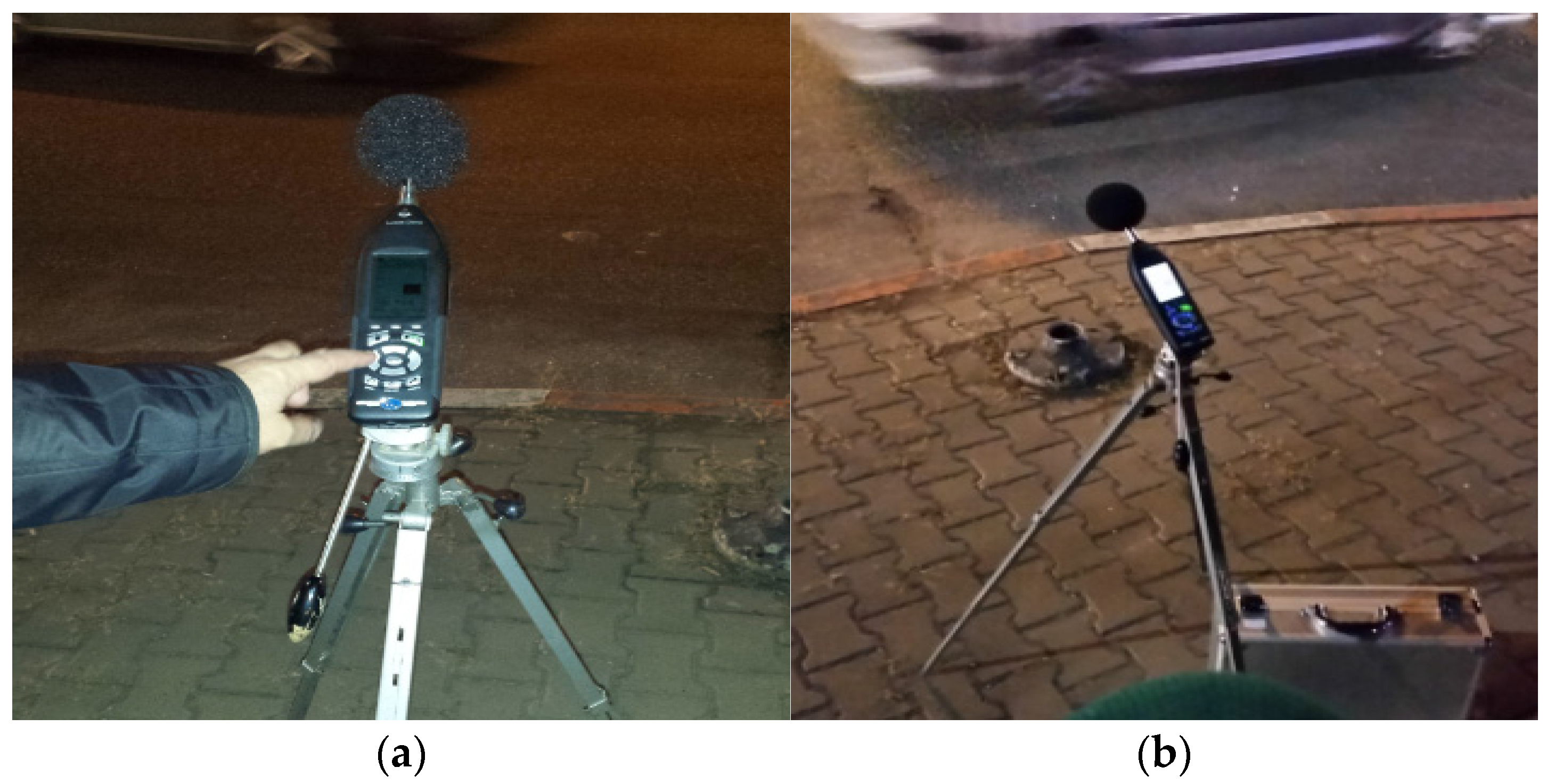

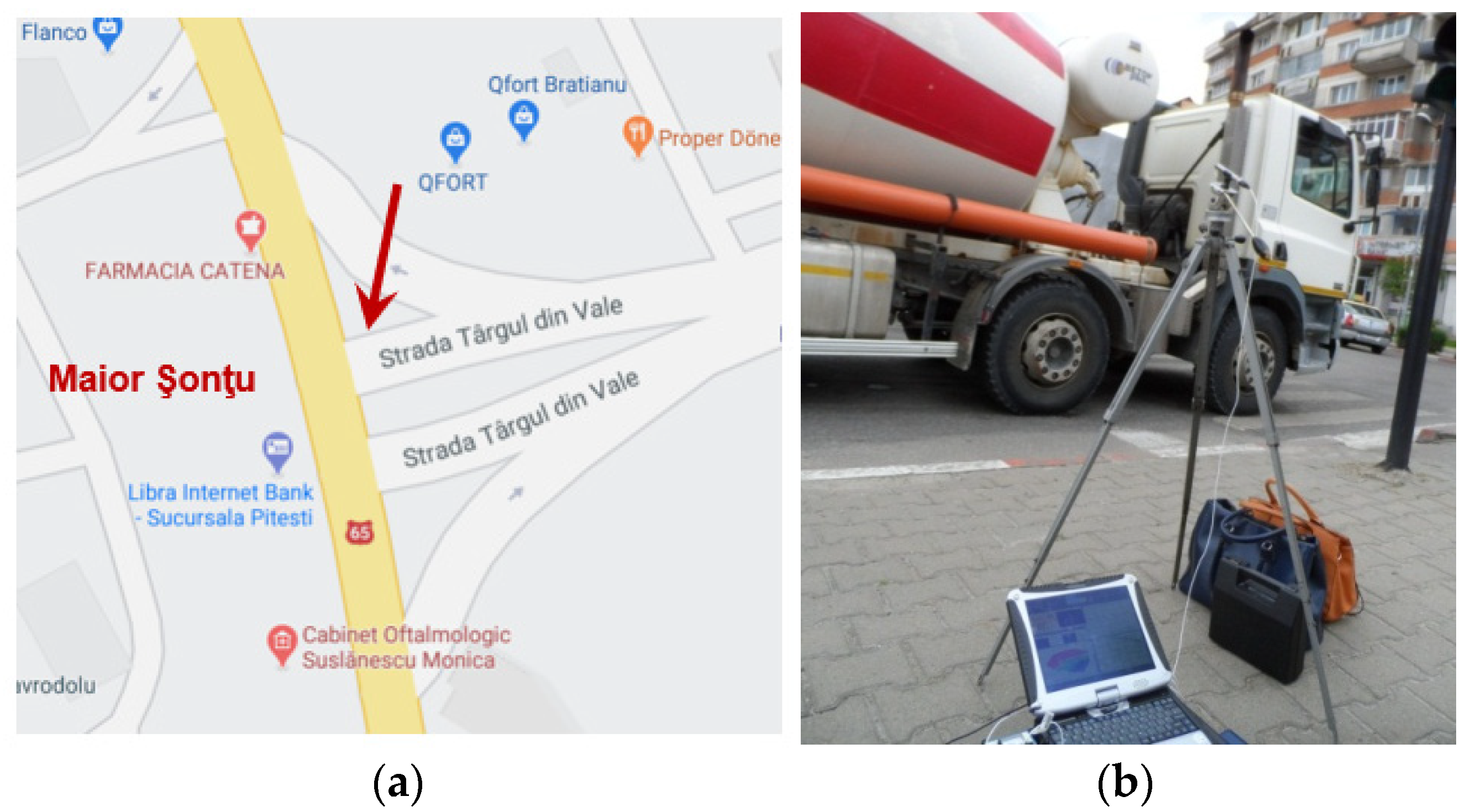
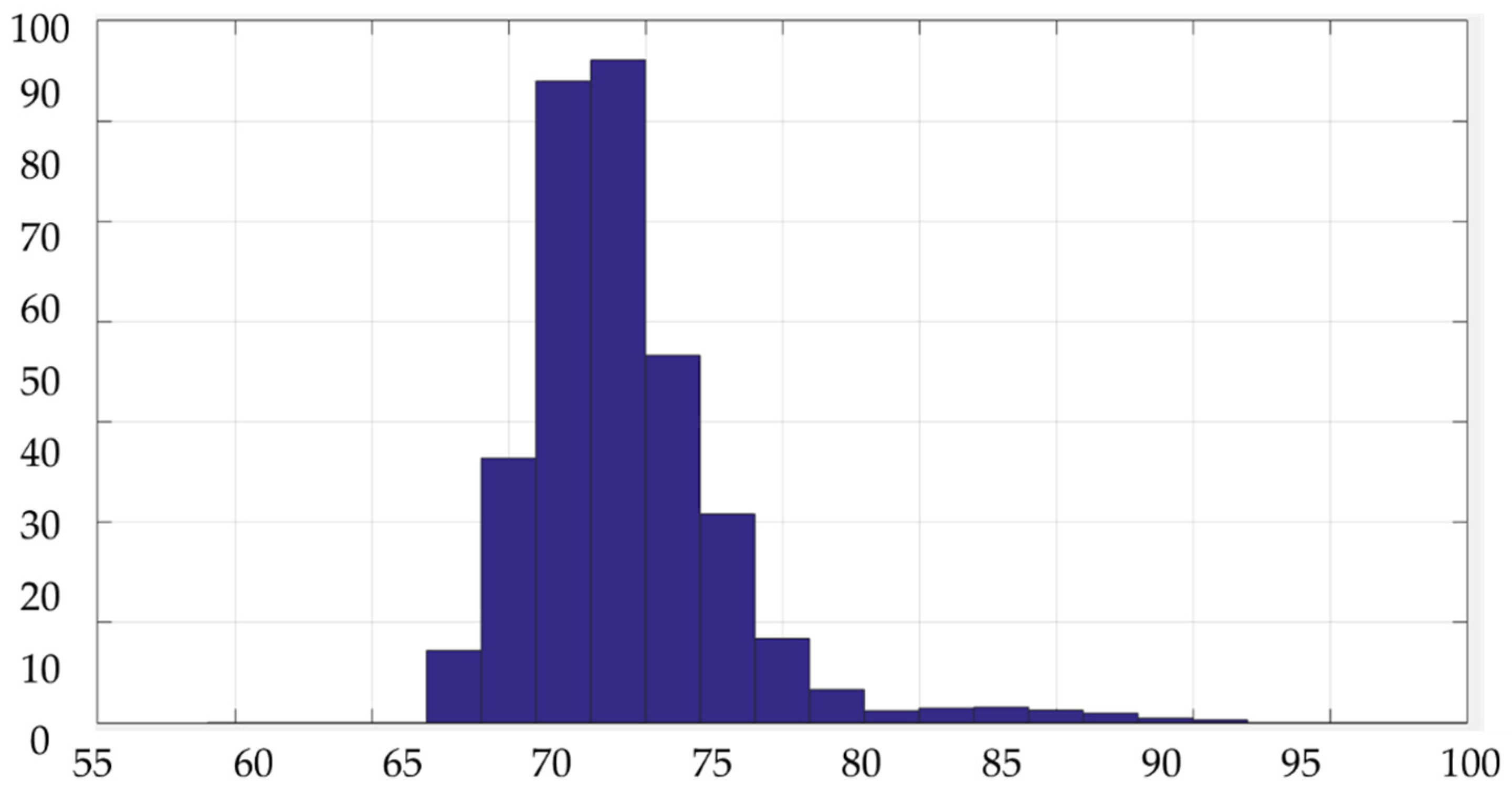
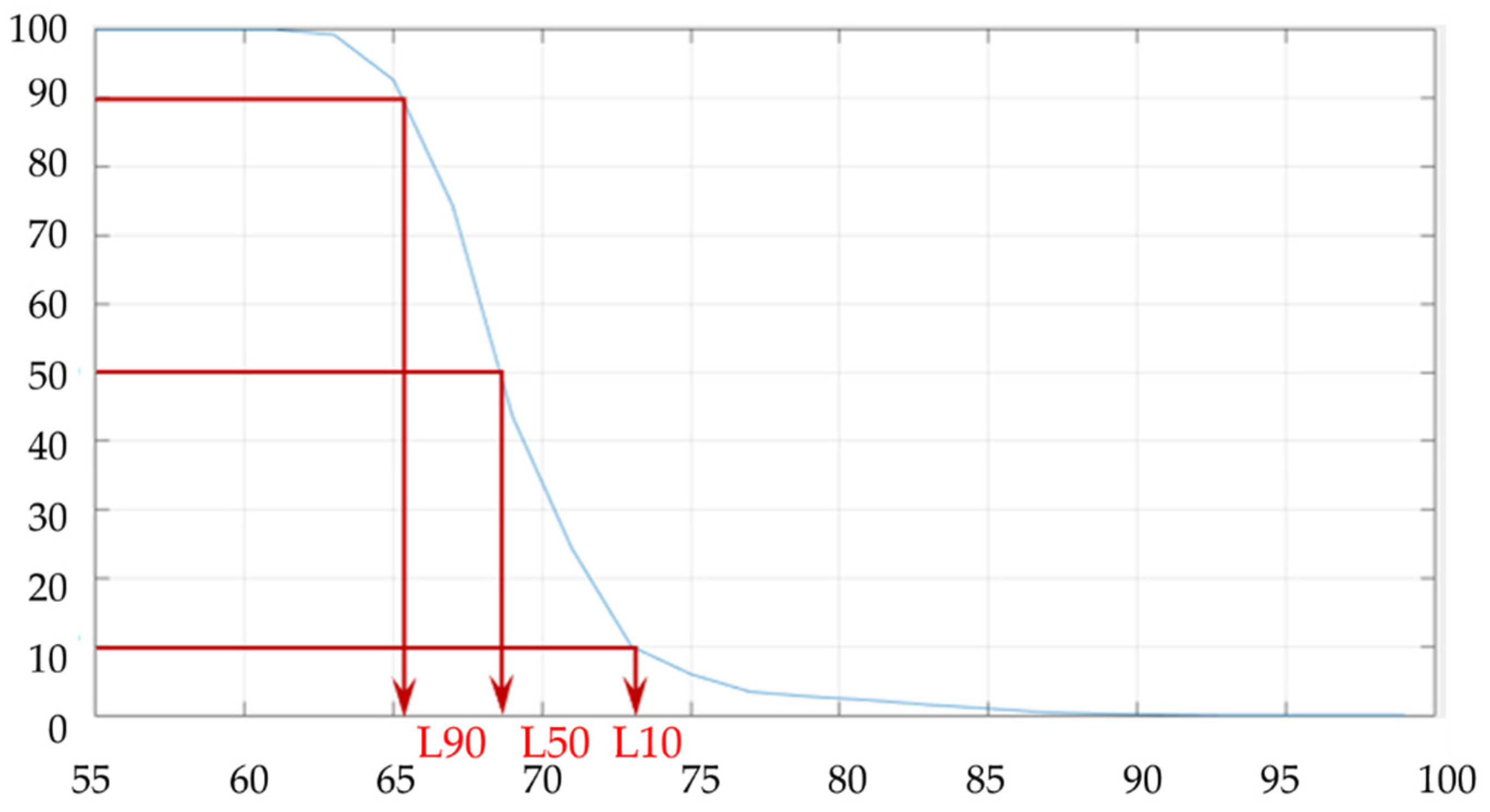
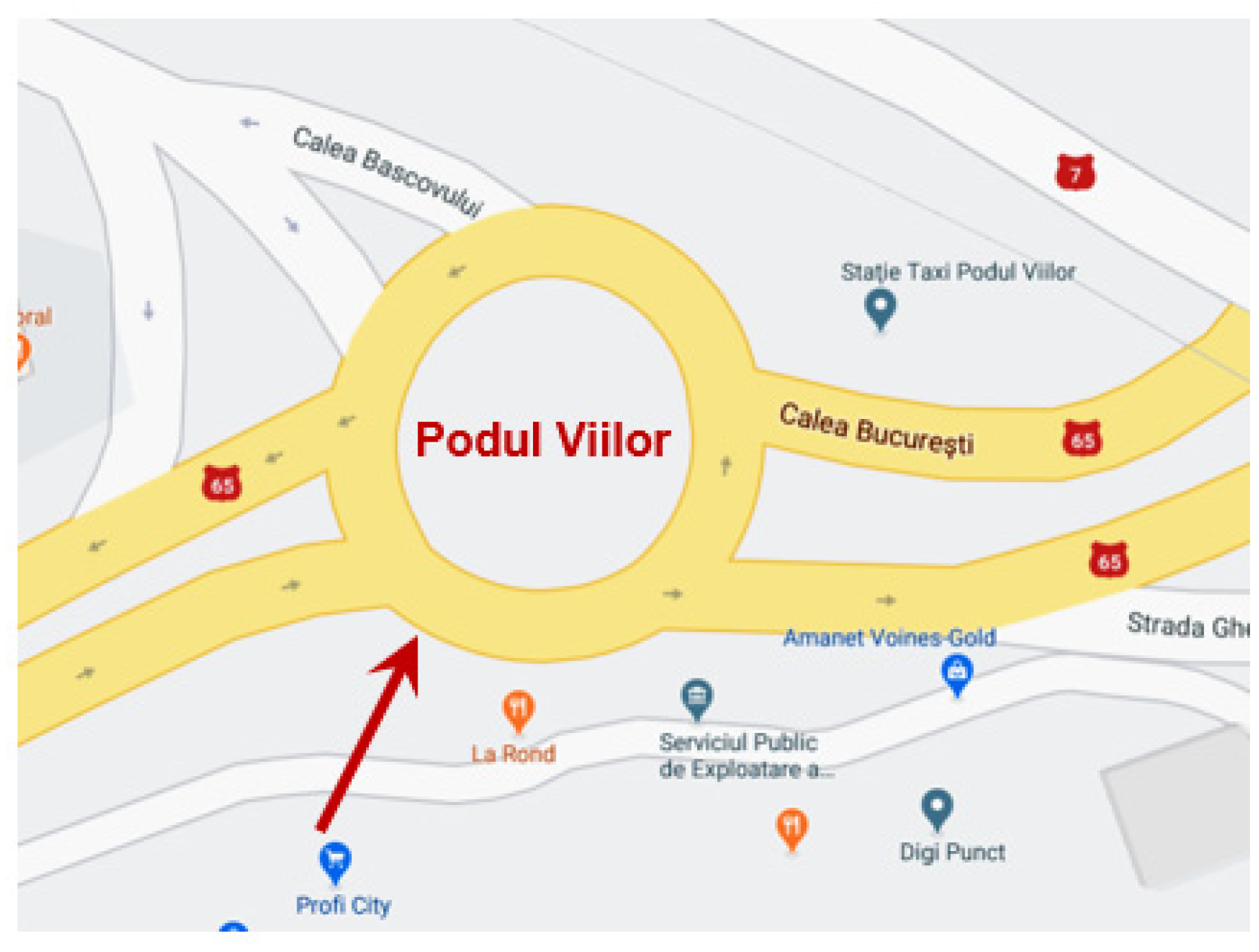

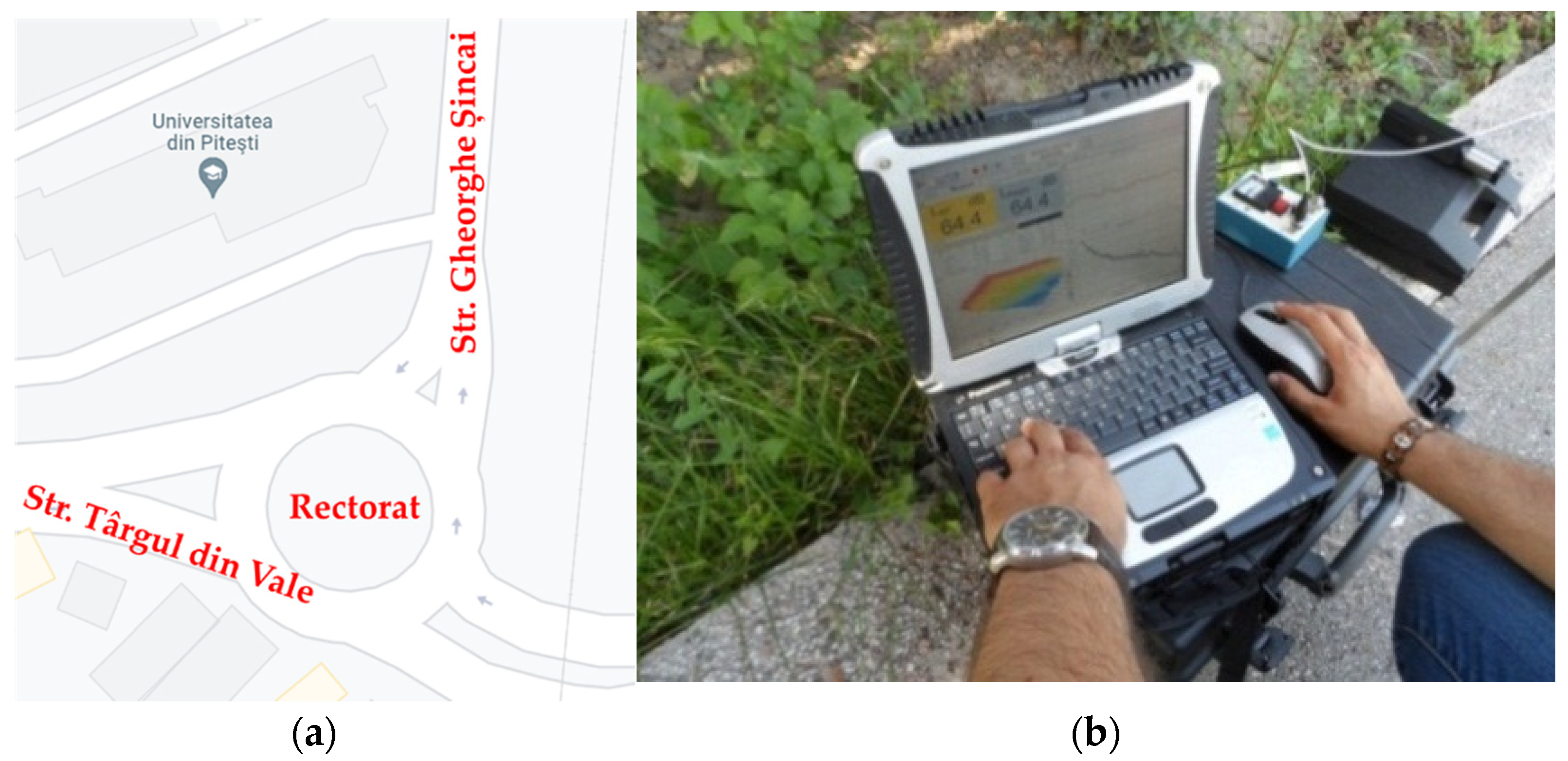
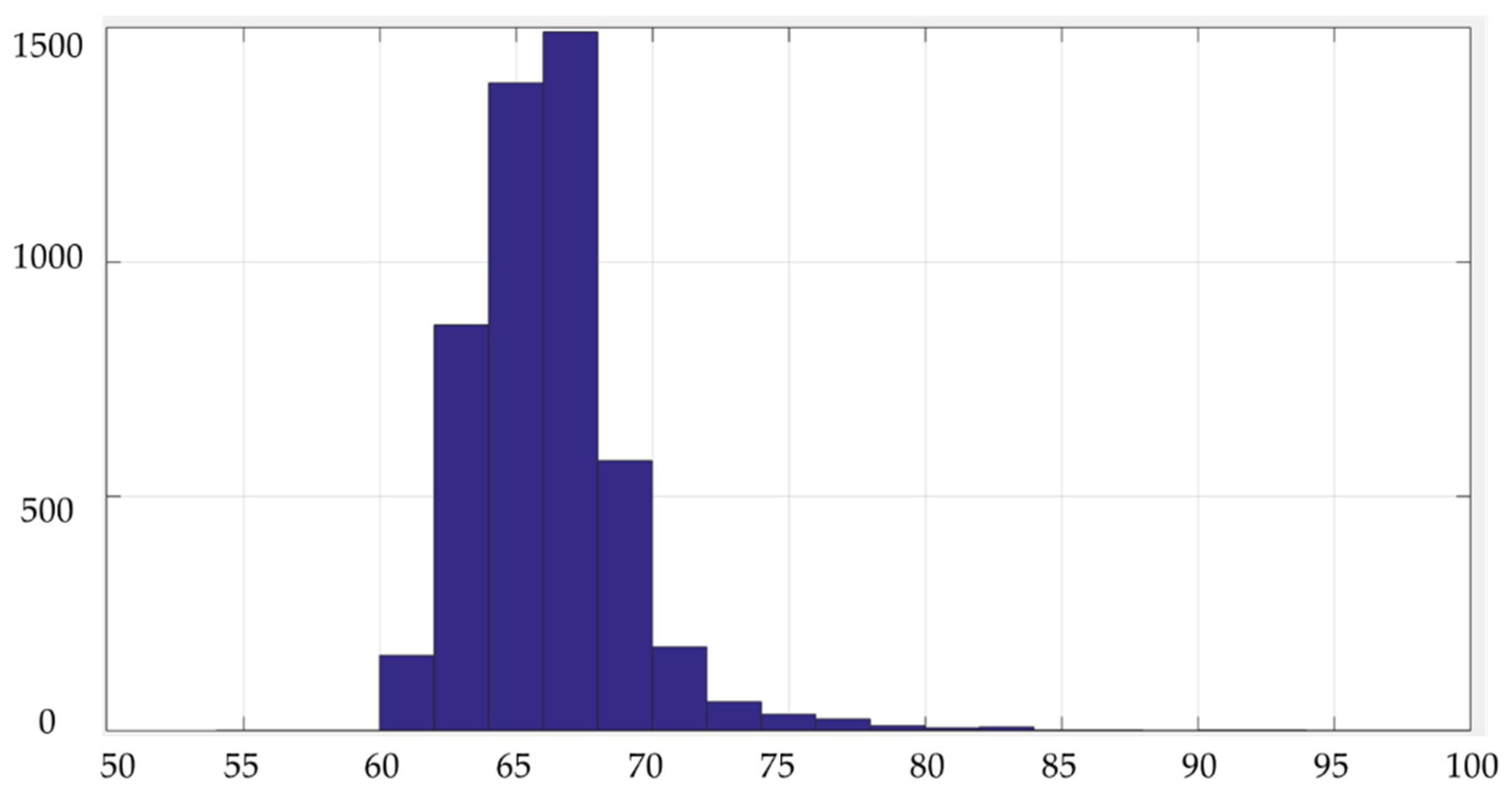
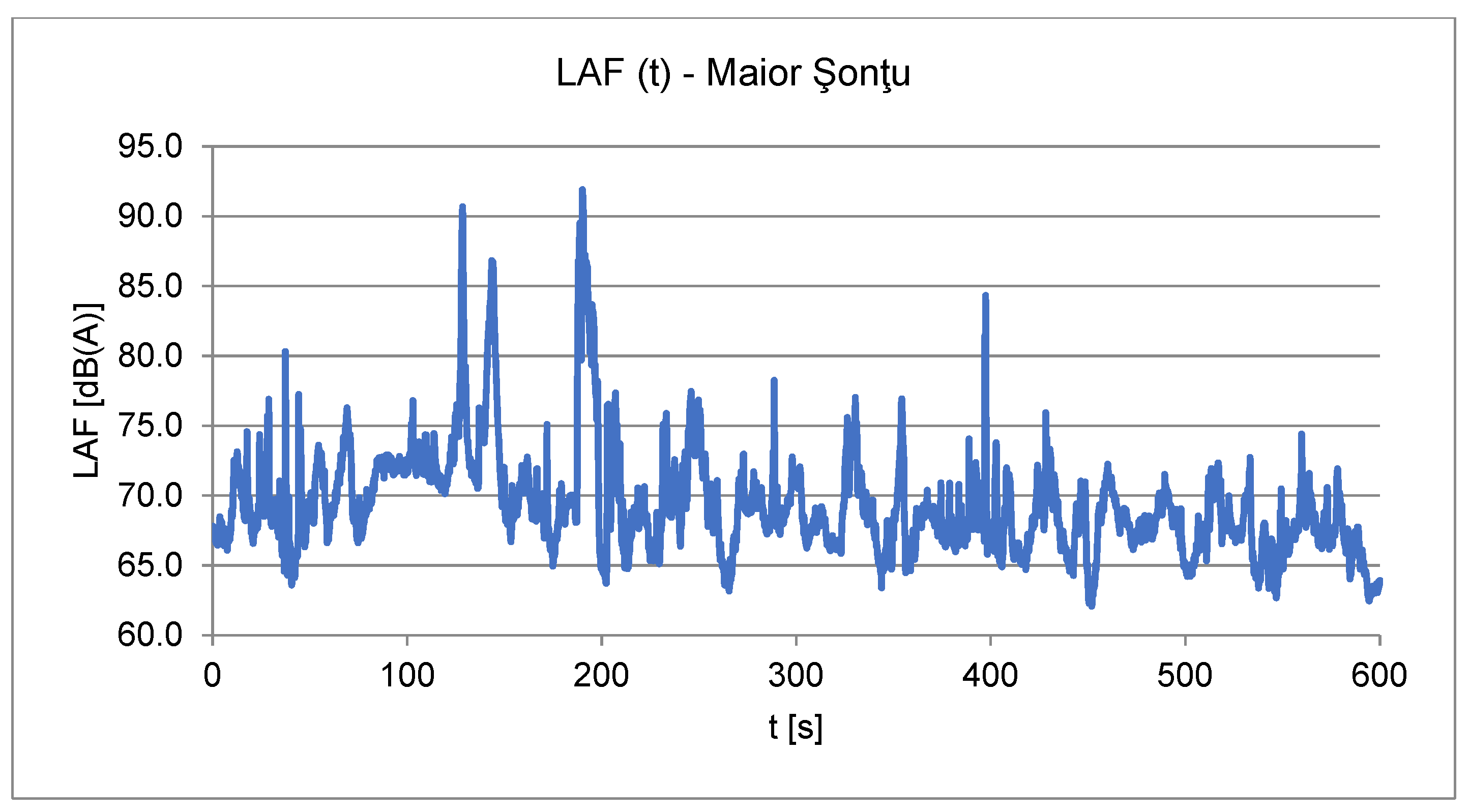
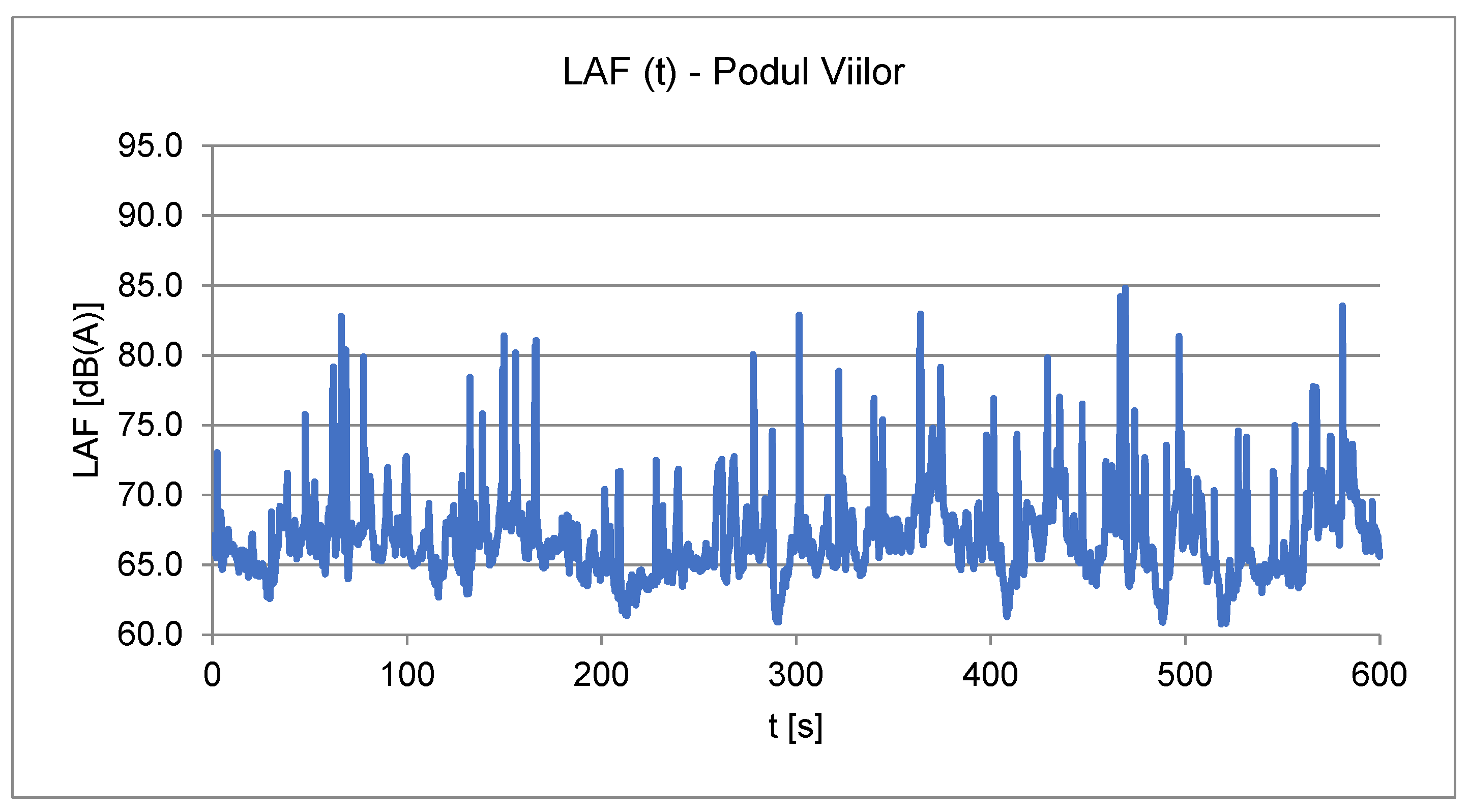
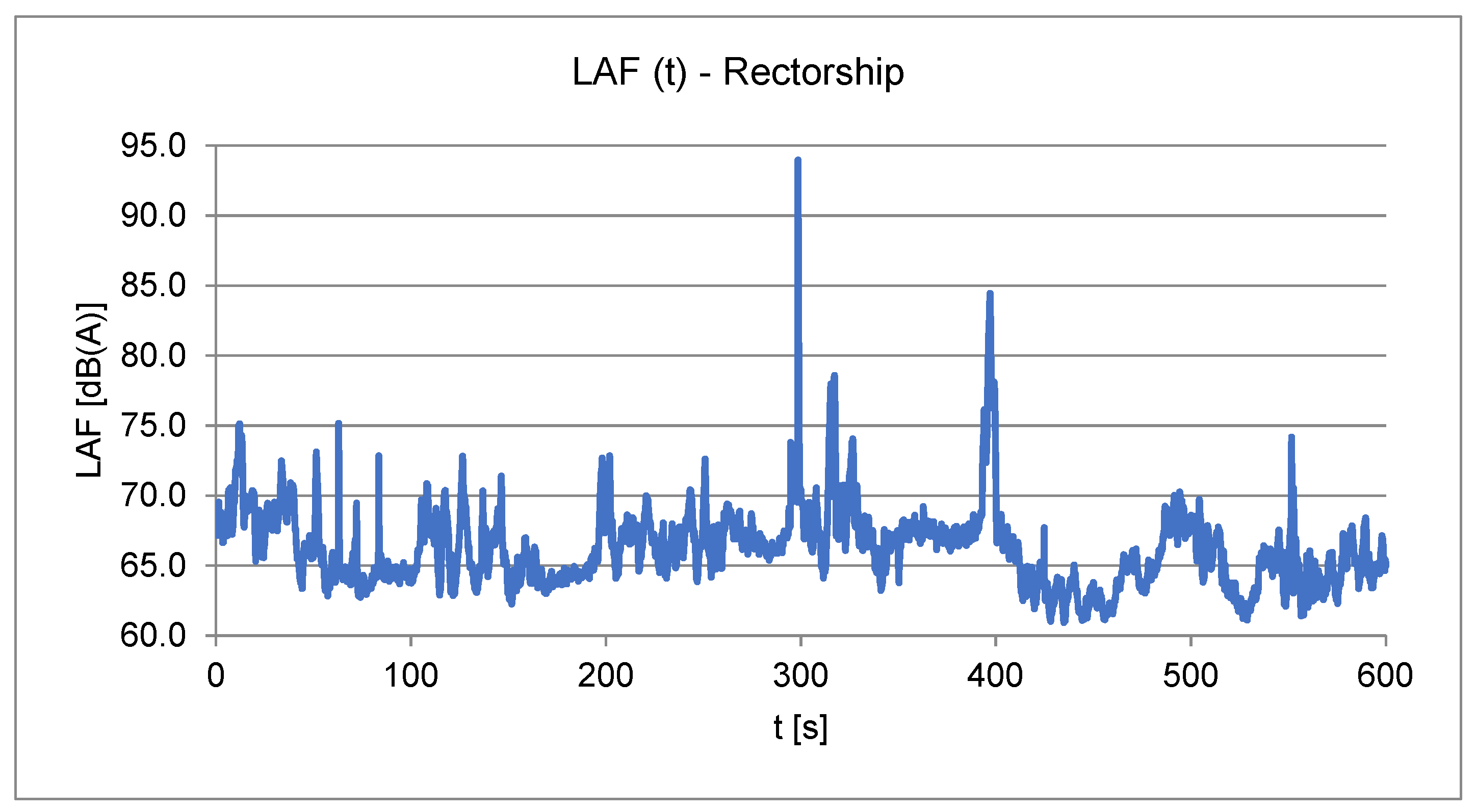
| Noise Parameter [dB(A)] | Maior Şonţu | Podul Viilor | Rectorship |
|---|---|---|---|
| Lmin | 62.1 | 60.8 | 60.9 |
| L90 | 65.5 | 64.0 | 63.1 |
| L50 | 68.6 | 66.4 | 66.0 |
| L10 | 73.1 | 70.4 | 69.3 |
| Lmax | 91.9 | 84.8 | 93.7 (78.6 after removing the two aberrant sound signals) |
| Average noise level Lm | 69.3 | 66.9 | 66.2 |
| Noise level standard deviation | 3.8 | 2.9 | 2.8 |
| Noise climate, c | 7.6 | 6.4 | 6.2 |
| Psychophysical index of acoustic pollution level LNP | 77.2 | 73.5 | 72.8 |
| Psychophysical index of traffic noise TNI | 65.9 | 59.6 | 57.9 |
| Psychophysical index Leq | 72.7 | 68.4 | 68.1 |
| Determining characteristics of traffic | cyclical traffic flows, composite traffic (light and heavy vehicles) | fluent traffic flows with “stop and go” regime, light traffic | fluent traffic flows, composite traffic (light and heavy vehicles) |
Publisher’s Note: MDPI stays neutral with regard to jurisdictional claims in published maps and institutional affiliations. |
© 2022 by the authors. Licensee MDPI, Basel, Switzerland. This article is an open access article distributed under the terms and conditions of the Creative Commons Attribution (CC BY) license (https://creativecommons.org/licenses/by/4.0/).
Share and Cite
Titu, A.M.; Boroiu, A.A.; Mihailescu, S.; Pop, A.B.; Boroiu, A. Assessment of Road Noise Pollution in Urban Residential Areas—A Case Study in Piteşti, Romania. Appl. Sci. 2022, 12, 4053. https://doi.org/10.3390/app12084053
Titu AM, Boroiu AA, Mihailescu S, Pop AB, Boroiu A. Assessment of Road Noise Pollution in Urban Residential Areas—A Case Study in Piteşti, Romania. Applied Sciences. 2022; 12(8):4053. https://doi.org/10.3390/app12084053
Chicago/Turabian StyleTitu, Aurel Mihail, Andrei Alexandru Boroiu, Sorin Mihailescu, Alina Bianca Pop, and Alexandru Boroiu. 2022. "Assessment of Road Noise Pollution in Urban Residential Areas—A Case Study in Piteşti, Romania" Applied Sciences 12, no. 8: 4053. https://doi.org/10.3390/app12084053
APA StyleTitu, A. M., Boroiu, A. A., Mihailescu, S., Pop, A. B., & Boroiu, A. (2022). Assessment of Road Noise Pollution in Urban Residential Areas—A Case Study in Piteşti, Romania. Applied Sciences, 12(8), 4053. https://doi.org/10.3390/app12084053










